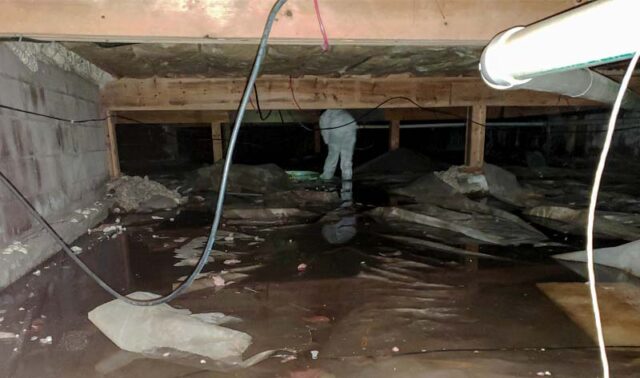If you’re a Florida homeowner with a crawl space foundation, it’s important to know that what’s going on under your home could be causing serious issues above it. Many crawl space issues happen out of sight, but not out of impact. That’s because your crawl space sits in direct contact with the ground, making it especially vulnerable in our humid Florida climate. This can result in moisture, mold, pests, energy loss, and eventually, major damage.
There’s a smart fix that can stop problems before they start. Crawl space encapsulation with professional air sealing and insulation, like spray foam, will help protect your home from the bottom up. Let’s walk through four common crawl space problems and how to solve them.
Problem 1: Moisture Damage
Moisture is the #1 Enemy
 Florida’s hot, humid air and rainy weather make your crawl space a magnet for moisture. Whether it’s from ground vapor, poor drainage, plumbing leaks, or even your AC unit’s condensation, water finds its way in. And a vented crawl space only makes it worse by pulling in more humid air from outside.
Florida’s hot, humid air and rainy weather make your crawl space a magnet for moisture. Whether it’s from ground vapor, poor drainage, plumbing leaks, or even your AC unit’s condensation, water finds its way in. And a vented crawl space only makes it worse by pulling in more humid air from outside.
This moisture builds up quietly below your home until it eventually causes some major headaches above it.
Mold and Mildew
Bare dirt floors are especially bad in damp environments. The constant humidity fuels mold growth on wood beams and insulation. You might not see the mold, but over time you may notice musty smells or allergy symptoms that affect your home’s indoor air quality.
Wood Rot
Moisture weakens the wood underneath your home, especially your floor joists and support beams. Over time, this can lead to structural damage, sagging floors, or even safety risks.
Solution: Spray Foam Defense
Stop moisture at the source. Combine proper drainage (ie. a sump pump), a vapor barrier, and spray foam insulation for total protection. Closed-cell spray foam adds insulation (R-value) and acts as a moisture barrier. It won’t absorb water or foster mold, unlike fiberglass.
Problem 2: Poor Air Quality
Stack Effect
Warm air rises and escapes through your attic, pulling new air up from below. That means the air in your crawl space, with all its odors, mold, and allergens, is getting pulled straight into your living space.
Airborne Contaminants
An unsealed crawl space allows mold spores, dust mites, and musty smells to enter through the tiny gaps in your floors, ducts, and ceilings. This can contribute to asthma and allergy symptoms, especially with prolonged exposure.
Solution: Encapsulation Strategy
Encapsulating your crawl space with a sealed vapor barrier on the floor and spray foam insulation along your walls and rim joists, locks out contaminated air. This helps ensure only clean, conditioned air from your HVAC system enters your home instead of stale crawl space air.
Problem 3: Pests
The Perfect Pest Hangout
Dark, damp environments like your crawl space are a paradise for pests. Rodents, insects, even snakes love to settle under your house, especially when it’s unsealed and moist.
Rodents and Insects
Rodents chew your wires and insulation, risking damage and fire hazards. Moist wood attracts carpenter ants, termites, and other wood-destroying insects. In fact, moisture makes your home more likely to face termite infestation.
Solution: Eliminate Access and Habitat
Encapsulating your crawl space helps keep pests out by removing the moisture that drew them in and closing their entry points. No moisture + no open gaps = no pest infestations. Don’t forget to call on your local pest control company for maximum whole house protection.
Problem 4: Lost Energy Dollars
Having an open or poorly insulated crawl space can waste significant energy and money by losing heat through various mechanisms.
Heat Loss Through Ducts
If your HVAC ducts run through a vented crawl space, you could be losing 25% to 40% of your heating or cooling energy. Energy escapes through air leaks and by conduction of heat. This makes your HVAC system work overtime to maintain comfort.
Cold and Hot Floor Problems
Leaving your crawl space floor uninsulated can lead to uncomfortable floors above. Your floors feel chilly in winter and warm in the summer, while your first-floor rooms are drafty. This is all due to the easy transfer of hot or cold air from your crawl space.
Solution: Energy-Saving Investment
The solution is to transform your crawl space from an energy loser into an energy saver. Experts recommend installing a minimum R-value of R-13 of insulation beneath your first level floor (the crawl space ceiling) and at least a 6-mil plastic vapor barrier on the crawl space ground. (New homes are required to meet the Florida building code standards for floors and crawl spaces.) Closed-cell spray foam insulation is the ideal choice because it provides both insulation and air sealing in one step. Taking these steps will lead to cozier floors above your crawl space and noticeable energy savings throughout your home.
The Bottom Line: It’s Time to Fix Your Crawl Space
 A sealed, insulated crawl space isn’t just cleaner, it’s safer, healthier, and more energy efficient.
A sealed, insulated crawl space isn’t just cleaner, it’s safer, healthier, and more energy efficient.
- Health Improvements: No more mold spores or musty air creeping into your home.
- Pest Prevention: Help keep out rodents, carpenter ants, and wood-destroying bugs by removing the moisture that draws pests and sealing off their entry points.
- Financial Benefits: Lower your energy bills thanks to better HVAC system efficiency and reduced heat/cooling loss.
- Structural Protection: Preserve your home’s structural integrity and avoid expensive crawl space repair and structural damage.
Don’t wait for sagging floors, high bills, or strange odors to tell you something’s wrong. Allweather Insulation has over 65 years of experience helping Florida homeowners protect their homes from the ground up. Whether you’re a homeowner or a builder, our spray foam and crawl space encapsulation services are the smart investment that pays off in comfort, savings, and peace of mind.
Contact us today for your free estimate and let’s seal the deal on energy efficiency for your Tallahassee home.
____________________________________________________________________________________
References
Connecticut Department of Public Health. “Insulation Fact Sheet.” Connecticut Department of Public Health, 2014, https://portal.ct.gov/-/media/departments-and-agencies/dph/dph/environmental_health/eoha/pdf/insulationfs12014revpdf.pdf.
ICC Digital Codes. “2023 Florida Building Code, Energy Conservation, Eighth Edition.” ICC Digital Codes, 2025, https://codes.iccsafe.org/content/FLEC2023P1/chapter-4-re-residential-energy-efficiency#FLEC2023P1_RE_Ch04_SecR402.1.2.
Lstiburek, Joseph W. “Better Duct Systems for Home Comfort, Health, and Energy Efficiency.” National Renewable Energy Laboratory, NREL/SR-550-30506, May 2005, https://docs.nrel.gov/docs/fy05osti/30506.pdf.
Mississippi State University Extension Service. “What Homebuilders Need to Know About Termites.” Mississippi State University Extension, 2025, https://extension.msstate.edu/publications/what-homebuilders-need-know-about-termites.
Office of Energy Efficiency and Renewable Energy. “Which Spray Foam is Right for You?” Energy.gov, 2009, https://www1.eere.energy.gov/buildings/publications/pdfs/building_america/spray_foam_guide.pdf.
This Old House. “7 Critical Problems in Your Crawl Space That Need Attention.” This Old House, 2025, https://www.thisoldhouse.com/foundations/121205/crawl-space-issues-and-solutions.
University of Florida Institute of Food and Agricultural Sciences. “Energy-Efficient Construction in Florida.” UF/IFAS Extension, EH107, 2025, https://wec.ifas.ufl.edu/extension/gc/madera/documents/EH107.pdf.
University of Missouri Extension. “Insulating and Weatherizing Your Home.” University of Missouri Extension, GH4881, 2025, https://extension.missouri.edu/publications/gh4881.
U.S. Environmental Protection Agency. “Mold Course Chapter 2.” EPA Mold Resources, 2025, https://www.epa.gov/mold/mold-course-chapter-2.
Washington State University Energy Program. “Crawl Space Construction and Insulation.” WSU Energy Program, 2025, https://www.energy.wsu.edu/Documents/crawlspace.pdf.


